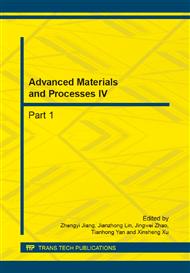[1]
Doubov AA. Screening of weld quality using the magnetic metal memory effect. Weld World 1998; 41: 196–8.
Google Scholar
[2]
Wilson J, Tian GY, Barrans S. Residual magnetic field sensing for stress measurement. Sens Actuators, a 2007; 135: 381–7.
DOI: 10.1016/j.sna.2006.08.010
Google Scholar
[3]
Doubov AA. The express-technique of welded joints examination with use of metal magnetic memory. NDT and E Int 2000; 33(6): 351–62.
Google Scholar
[4]
Doubov AA. A study of metal properties using the method of magnetic memory. Met Sci Heat Treat 1997; 39: 401–2.
Google Scholar
[5]
Tingjun Yan, Jiedong Zhang, Guodong Feng, Jianfei Chen. Early Inspection of Wet Steam Generator Tubes Based on Metal Magnetic Memory Method. Procedia Engineering 2011; 15: 1140-1144.
DOI: 10.1016/j.proeng.2011.08.210
Google Scholar
[6]
C.L. Shi S.Y. Dong B.S. Xu,P. He. Metal magnetic memory effect caused by static tension load in a case-hardened steel. Journal of Magnetism and Magnetic Materials 2010; 322(4): 413-416.
DOI: 10.1016/j.jmmm.2009.09.066
Google Scholar
[7]
Li Xiao-meng, Ding Hong-sheng, Bai Shi-wu. Research on the stress-magnetism effect of ferromagnetic materials based on three-dimensional magnetic flux leakage testing. NDT&E International. 2014; 62: 50-54.
DOI: 10.1016/j.ndteint.2013.11.002
Google Scholar
[8]
Doubov AA. Express method of quality control of a spot resistance welding with usage of metal magnetic memory. Weld World 2002; 46: 317–20.
Google Scholar
[9]
Dai daosheng. Ferromagnetic school,Beijing: Science Press,(1992).
Google Scholar
[10]
Dong lihong, xubingshi. Progress in Life Prediction of Remanufacturing Blanks by Using Metal Magnetic Memory Testing. China Surface Engineering. 2006: z1: 71-75.
Google Scholar
[11]
Z.D. Wang, K. Yao,B. Deng K.Q. Ding. Quantitative study of metal magnetic memory signal versus local stress concentration. NDT & E International, 2010; 43(6): 513-518.
DOI: 10.1016/j.ndteint.2010.05.007
Google Scholar
[12]
L.J. Yang, B. Liu, L.J. Chen, S.W. Gao. The quantitative interpretation by measurement using the magnetic memory method (MMM)-based on density functional theory. NDT & E International, 2013; 55: 15-20.
DOI: 10.1016/j.ndteint.2013.01.002
Google Scholar


